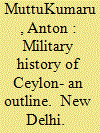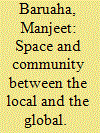|
|
|
Sort Order |
|
|
|
Items / Page
|
|
|
|
|
|
|
| Srl | Item |
| 1 |
ID:
106876


|
|
|
|
|
| Publication |
2011.
|
| Summary/Abstract |
According to the existing studies on Myanmar's economic history, agricultural land in the Lower Myanmar delta was transferred from 'agriculturists' to 'non-agriculturists' under British colonial rule. However, a clear distinction could not be drawn between the agriculturists and non-agriculturists as was generally thought with respect to their economic activity. More importantly, the categories could be applied interchangeably. The purpose of this study is to reconsider the very concept of 'agriculturist' as a colonial category in British Burma by exploring the hitherto unused register of holdings (Register IA, U pain hmatpoun sayin).
|
|
|
|
|
|
|
|
|
|
|
|
|
|
|
|
| 2 |
ID:
128143


|
|
|
|
|
| Publication |
2014.
|
| Summary/Abstract |
Dynamics of Indian Diaspora in East Africa has been continuous point of attraction for researchers, academicians, policy makers and even general audience. Even a cursory glance reveals that dozens of research has been carried out by scholars and numerous literatures are available on the subject. However, there have been significant changes in the focus of the research. In the colonial period, political activism of Indians in East Africa was a major point contention between colonial power and nationalist leaders which is clearly visible in the writings of CF Andrews (Indian question in East Africa, 1921).
|
|
|
|
|
|
|
|
|
|
|
|
|
|
|
|
| 3 |
ID:
027156


|
|
|
|
|
| Publication |
New Delhi, Navrang, 1987.
|
| Description |
229p.hbk
|
| Standard Number |
8170130468
|
|
|
|
|
|
|
|
|
|
|
|
Copies: C:1/I:0,R:0,Q:0
Circulation
| Accession# | Call# | Current Location | Status | Policy | Location |
| 028557 | 954.93/MUT 028557 | Main | On Shelf | General | |
|
|
|
|
| 4 |
ID:
144338


|
|
|
|
|
| Summary/Abstract |
Although it is a tenet of political science that the modern state possesses a ‘monopoly of violence’, governments have repeatedly used militias outside the formal chain of command of their armed forces when waging counterinsurgency (COIN), and in recent conflicts the USA, UK, and other Western powers have used irregular forces when fighting insurgencies in Iraq and Afghanistan. War-weariness and financial austerity is likely to encourage American and allied policymakers to rely on auxiliaries as proxies, despite the fact that historical experience demonstrates that the use of militias in COIN can have counterproductive consequences, not least for state stability. This article also concludes that the tendency of some Middle Eastern states (notably Iraq and Syria) to ‘coup-proof’ their militaries renders them even more dependent on militias in the face of a sustained internal revolt, as their regular armed forces collapse under the stress of combat. In this respect, there is a direct link between ‘coup-proofing’, dependence on irregular auxiliaries in civil war, and the erosion of the state’s integrity.
|
|
|
|
|
|
|
|
|
|
|
|
|
|
|
|
| 5 |
ID:
126658


|
|
|
|
|
| Publication |
2013.
|
| Summary/Abstract |
The objective of this article is to situate the relation between the local and the global in the context of a specific region formation, namely the Brahmaputra Valley of Assam in India as a frontier. The article takes up two examples on the relation between space and community construct and how the relation forms part of the deeper relation between the local and the global in the Valley. The Brahmaputra Valley comprises the major area of the Indian state of Assam. Assam and its neighbouring areas are also referred to as 'North East India'. The term came into use during the colonial period. It was used to refer to the British-Indian frontier which bordered on Bhutan, Tibet, China and Myanmar. In the first example of the article, the local-global relation is seen in terms of how the colonial-capitalism paradigm altered the pre-colonial socio-spatial relation, formulating and implementing new spatial and social classifications. The focus in the example is on the rearrangement of socio-spatial relations in the Valley as part of transforming a pre-colonial crossroads into a colonial frontier. In the second example, the relation between space and community construct is situated in popular responses to the above changes, and especially how international ideology like communism is appropriated to address the local specificity of frontier. The works of the cultural icon and peasant leader of the Valley, Bishnu Rabha, are discussed in detail. Through the interrelation between the two examples, the article tries to show how between the nineteenth and the mid-twentieth century the local specificity of the Valley as a frontier was possible precisely due to changes of state formation or ideology which drew on a global context. In other words, the relation between space and community construct in the Valley demonstrates how the coexistence of the local and the global was a necessary condition in its making as a frontier. Community constructs like 'tribe', 'Assamese' and 'Ahom' during the period formed part of this interrelation between the local and the global that
|
|
|
|
|
|
|
|
|
|
|
|
|
|
|
|
|
|
|
|
|